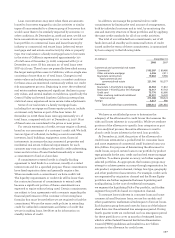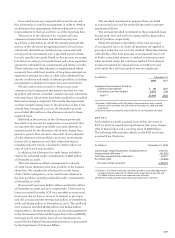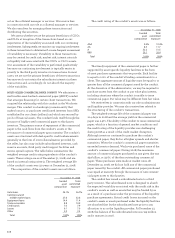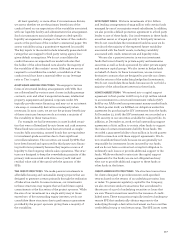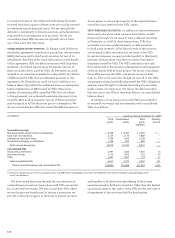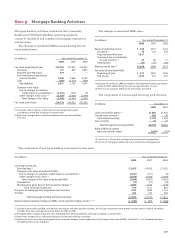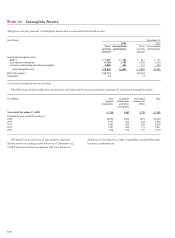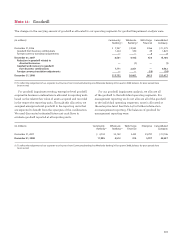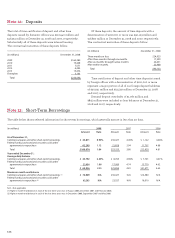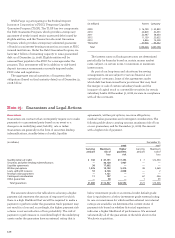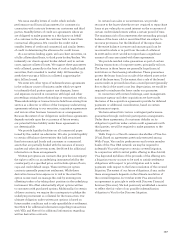Wells Fargo 2008 Annual Report Download - page 119
Download and view the complete annual report
Please find page 119 of the 2008 Wells Fargo annual report below. You can navigate through the pages in the report by either clicking on the pages listed below, or by using the keyword search tool below to find specific information within the annual report.
At least quarterly, or more often if circumstances dictate,
we assess whether we are the primary beneficiary of the
conduit based on our expectation of the variability associated
with our liquidity facility and administrative fee arrangement.
Such circumstances may include changes to deal-specific
liquidity arrangements, changes to the terms of the conduit’s
assets or the purchase of the conduit’s commercial paper. We
assess variability using a quantitative expected loss model.
The key inputs to the model include internally generated risk
ratings that are mapped to third party rating agency loss-
given-default assumptions. We do not consolidate the
conduit because our expected loss model indicates that
the holder of the subordinated note absorbs the majority of
the variability of the conduits’ assets. Although we are not
required to consolidate the conduit, consolidation of the
conduit would not have a material effect on our leverage
ratio or Tier 1 capital.
ASSET-BASED LENDING STRUCTURES We engage in various
forms of structured lending arrangements with VIEs that
are collateralized by various asset classes including energy
contracts, auto and other transportation leases, intellectual
property, equipment and general corporate credit. We
typically provide senior financing, and may act as an interest
rate swap or commodity derivative counterparty when
necessary. In most cases, we are not the primary beneficiary
of these structures because we do not retain a majority of
the variability in these transactions.
For example, we had investments in asset backed securi-
ties that were collateralized by auto leases and cash reserves.
These fixed-rate securities have been structured as single-
tranche, fully amortizing, unrated bonds that are equivalent
to investment-grade securities due to their significant
overcollateralization. The securities are issued by SPEs that
have been formed and sponsored by third party auto financ-
ing institutions primarily because they require a source of
liquidity to fund ongoing vehicle sales operations. The struc-
tures are designed to keep the overwhelming majority of the
primary risks associated with structures (credit risk and
residual value risk of the autos) with the sponsors of the
SPEs.
TAX CREDIT STRUCTURES We make passive investments in
affordable housing and sustainable energy projects that are
designed to generate a return primarily through the realization
of federal tax credits. In some instances, our investments
in these structures may require that we fund future capital
commitments at the discretion of the project sponsors. While
the size of our investment in a single entity may at times
exceed 50% of the outstanding equity interests, we do not
consolidate these structures due to performance guarantees
provided by the project sponsors giving them a majority of
the variability.
INVESTMENT FUNDS We have investments of $2.1 billion
and lending arrangements of $349 million with certain funds
managed by one of our majority owned subsidiaries. In addition,
we also provide a default protection agreement to a third party
lender to one of these funds. Our involvements in these funds
are either senior or of equal priority to third party investors.
We do not consolidate the investment funds because we do
not absorb the majority of the expected future variability
associated with the funds’ assets, including variability
associated with credit, interest rate and liquidity risks.
We are also a passive investor in various investment
funds that invest directly in private equity and mezzanine
securities as well as funds sponsored by select private equity
and venture capital groups. We also invest in hedge funds
on behalf of clients. In these transactions, we use various
derivative contracts that are designed to provide our clients
with the returns of the underlying hedge fund investments.
We do not consolidate these funds because we do not hold a
majority of the subordinate interests in these funds.
MONEY MARKET FUNDS We entered into a capital support
agreement in first quarter 2008 for up to $130 million related
to an investment in a structured investment vehicle (SIV)
held by our AAA-rated non-government money market funds.
In third quarter 2008, we fulfilled our obligation under this
agreement by purchasing the SIV investment from the funds.
At December 31, 2008, the SIV investment was recorded as a
debt security in our securities available-for-sale portfolio. In
addition, at December 31, 2008, we had outstanding support
agreements of $101 million to certain other funds to support
the value of certain investments held by those funds. We
recorded a guarantee liability of $10 million in fourth quarter
2008 in connection with these support agreements. We do
not consolidate these funds because we are generally not
responsible for investment losses incurred by our funds,
and we do not have a contractual or implicit obligation to
indemnify such losses or provide additional support to the
funds. While we elected to enter into the capital support
agreements for the funds, we are not obligated and may
elect not to provide additional support to these funds or
other funds in the future.
CREDIT-LINKED NOTE STRUCTURES We structure transactions
for clients designed to provide investors with specified
returns based on the returns of an underlying security, loan
or index. To generate regulatory capital for the Company,
we also structure similar transactions that are indexed to
the returns of a pool of underlying securities or loans that
we own. These transactions result in the issuance of credit-
linked notes. These transactions typically involve a bankruptcy
remote SPE that synthetically obtains exposure to the
underlying through a derivative instrument such as a written
credit default swap or total return swap. The SPE issues notes


